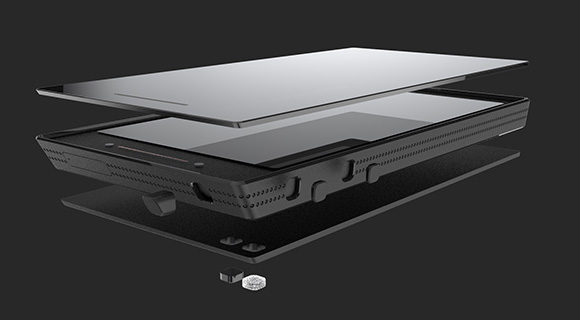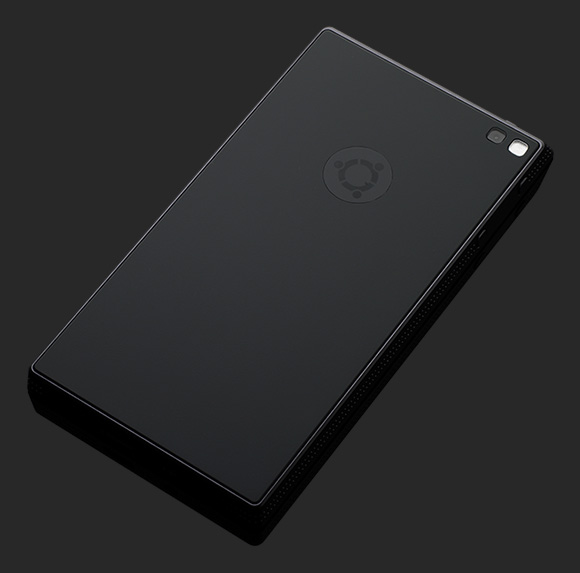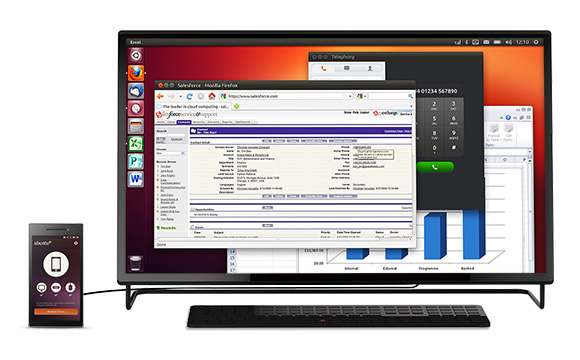Imagine, for a second, the power of a tablet or even an Ultrabook in a device that fits into your pocket. A device so powerful that when you connect it to your personal computer or laptop, it runs on the same software environment, negating the need of syncing or transferring data. And, with at least 4GB of RAM and an unheard-of 128GB of flash storage in the device, there’s no worries about storage or memory issues, either.
We’ve seen some pretty powerful smartphones making their debut this year, and we’re sure to see more super phones come the next few months. But none, it can safely be said, will come close to this.
The Ubuntu Edge.
Article continues after the jump.
A pioneering project by Canonical, the Ubuntu Edge is a concept smartphone with a lofty aim of “accelerating the adoption of new technologies and drives them down into the mainstream”. We’ve seen a similar project earlier this year with Jolla and their first-ever smartphone running on the new Sailfish mobile operating system, but the scale with which the Ubuntu Edge is being promoted is breathtaking.

Canonical likens the Ubuntu Edge project as a testbed for the mobile industry, and provides an analogy to the automotive industry where pioneering innovations and cutting-edge technology make their way into Formula 1 cars before moving down into the mainstream vehicles. As such, the Ubuntu Edge aims to be the single most powerful mobile device ever created, packed with hardware that is surpassed only by the innovation required to fit them into a smartphone chassis that is only 9mm thin.
The device, which is expected to be available sometime in May 2014, will be crafted from a single block of “textured amorphous metal” with chamfered edges that fit naturally in the palm. The display will be a 4.5-inch 720p panel, which according to Canonical’s research (and, it must be said, that of Jolla’s) is the perfect screen size for “comfortable control of all four edges with one hand”. The choice of a 720p panel is an interesting one, too. Canonical is actively going against the high-density screens seen today as a stance against yet another numbers race: “beyond 300ppi you’re adding overhead rather than improving display clarity.”
That’s not all. The screen on the Ubuntu Edge is virtually scratch-proof – instead of the usual Gorilla Glass, the Ubuntu Edge will have a screen made from sapphire crystal, one of the hardest materials known to man. It is so tough, only diamonds can scratch it. We’ve already seen the use of sapphires in mobile devices with the iPhone 5’s camera lens, not to mention several companies already working on synthesizing sapphire crystals for mass production for smartphone displays, so the use of sapphire displays looks likely in the future.
Inside, the Ubuntu Edge will be powered by the “fastest available multi-core processor”, at least 4GB of RAM and an astounding 128GB of storage. There’s more innovation on the battery as well: the battery on the Ubuntu Edge will utilize silicon-anode technology, which delivers extended cycle life and significantly increases battery capacity. On top of that, the Ubuntu Edge will also feature two LTE radios, allowing for LTE connectivity on any band.

On the software front, the Ubuntu Edge smartphone will run on a dual-OS environment of Ubuntu Touch and Android. We’ve seen a fair bit of Ubuntu Touch running on the Google Nexus devices and other unlocked Android devices, as well as its convergence capability that allows it to “morph” into a full-featured desktop OS when connected to a dock and monitor.
Dual-booting Android is more of a strategic move by Canonical, as it opens up a wealth of Android apps – and thus, developers – into the Ubuntu environment. Not only that, the Ubuntu Touch OS also supports HTML 5 standards for web apps, while QML toolkit from the Qt framework can also be used for richer applications. Finally, the Ubuntu SDK allows developers to code once and upload a native app with desktop, tablet and phone-optimized interfaces.
But wait. The Ubuntu Edge will not be a commercial device, and will not be mass-produced. Instead, the device is now on a month-long crowd-funding phase powered by Indiegogo. And, like other crowd-funded projects, higher pledges unlocks greater perks such as an exclusive 24-hour promo price, a place in the Ubuntu Founders page, and even an exclusive VIP invite to the unveiling event with Canonical founder Mark Shuttleworth.
As it stands, we’re barely three hours in since funding was open on Indiegogo, backers have already funded close to $500,000 out of an ambitious goal of raising $32 million. If the funding continues at this rate, it is highly likely that the Ubuntu Edge project will be successfully funded, and this limited edition device will head into production.
For more information about the Ubuntu Edge device, head on to the Indiegogo page here.
Follow us on Instagram, Facebook, Twitter or Telegram for more updates and breaking news.






